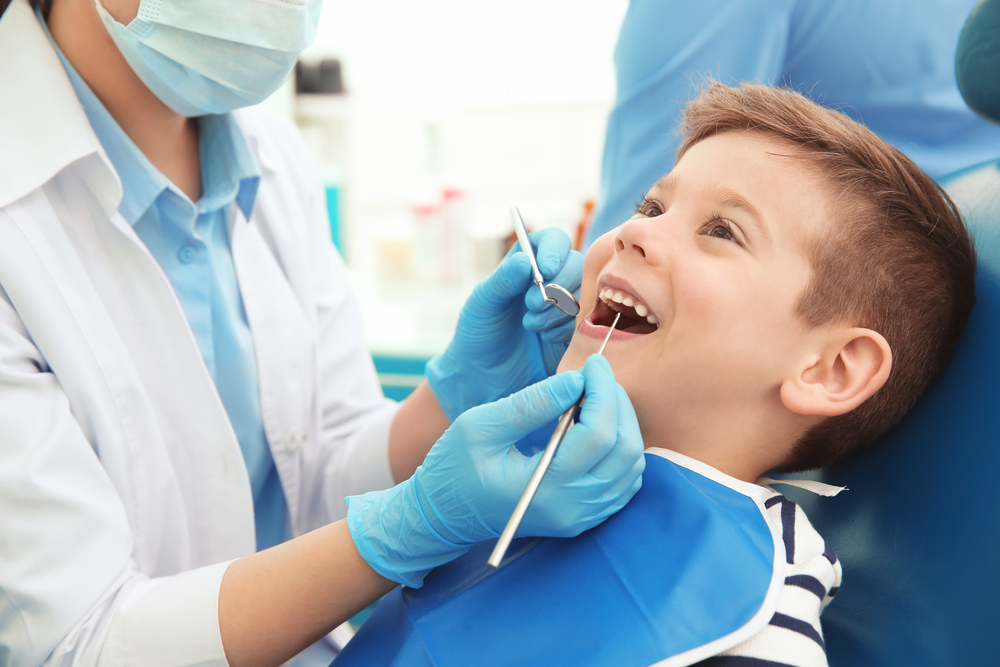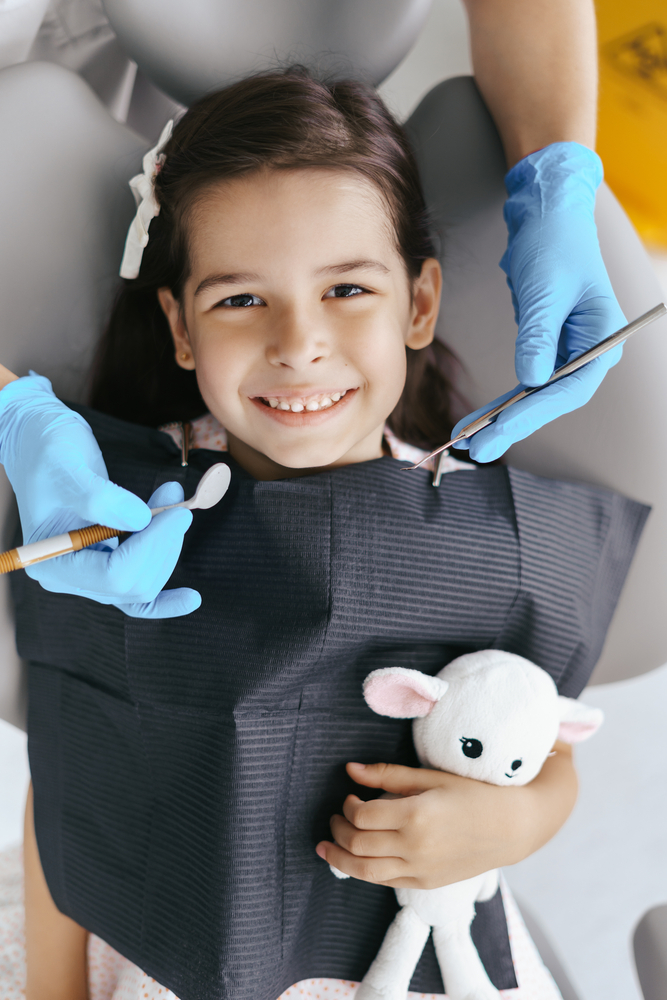1812 E. Broadway St.
Pearland, TX 77581
Pulpotomy is a word that may sound intimidating to parents whose children need dental treatment, but this procedure is actually a gentle and effective way to treat decay in baby teeth while preventing further damage. At Pearland Dental Group, Dr. Rushi Dave and Dr. Mili Shah provide comprehensive pulpotomy treatment with gentle care designed specifically for children in Pearland, TX, and surrounding areas such as Pasadena, Fresno, and Alvin.
Please note: We may not offer this service at our Pearland, TX, dental practice. Contact (281) 993-9900 for more information about our pediatric dental services and treatment availability.
A pulpotomy is a specialized dental procedure that removes infected pulp tissue from a child’s tooth while preserving as much of the healthy pulp as possible. The dental pulp is the soft tissue inside a tooth that contains blood vessels, nerves, and connective tissue essential for tooth vitality. This procedure serves as a more conservative alternative to pediatric root canal therapy for children experiencing problems with their primary teeth.
While pulpotomy procedures may occasionally be performed on permanent teeth in specific cases where the pulp is damaged but the root structure remains healthy enough to support the tooth, root canal therapy is typically the preferred treatment option for addressing pulp-related issues in permanent teeth. The primary focus of pulpotomy treatment remains the preservation of primary teeth until they naturally exfoliate.
This conservative approach allows us to save your child’s natural tooth structure and maintain proper oral development. Discover more about this important pediatric dentistry procedure with our Pearland dental team by calling (281) 993-9900.
At Pearland Dental Group, we understand that your child’s comfort and dental health are your top priorities. Dr. Rushi Dave and Dr. Mili Shah can provide gentle pediatric procedures, creating a calm, child-friendly environment where young patients feel safe and secure during their pulpotomy treatment. Our Pearland dental practice utilizes the latest pain management techniques and child-centered approaches, ensuring your little one experiences minimal discomfort while receiving the highest quality endodontic care available in the greater Houston area.
What sets us apart is our commitment to making dental care accessible for every family in our community. Our knowledgeable staff works diligently with your dental insurance provider to secure maximum coverage for your child’s pulpotomy procedure, while also offering family-friendly payment plans that fit your budget.
Perfectly positioned near family favorites like the Houston Zoo, Houston Botanic Garden, and Shaw Art Gallery, our Pearland location makes it easy to turn your child’s dental visit into a fun family outing, helping create positive associations with dental care that will benefit them for life.
A pulpotomy becomes necessary when a baby tooth is significantly affected by tooth decay that has progressed beyond the outer layers of the tooth. The affected tooth typically presents with extensive dental caries that have penetrated the pulp tissue in the crown portion of the tooth but have not yet reached the root canals, resulting in a condition called pulpitis.
Pulpitis represents inflammation of the pulp tissue and manifests through several concerning symptoms that parents should recognize:
If left untreated, pulpitis can progress to more serious complications, including the spread of dental infection to the root portions of the tooth, which can result in abscess formation, facial swelling, and severe pain that may interfere with your child’s sleep, eating, and daily activities.
A pulpotomy procedure offers numerous important benefits for children’s dental health and overall development, making it an invaluable treatment option for preserving primary tooth function.
By removing the infected pulp tissue while preserving the healthy tooth pulp, a pulpotomy can save a tooth from extraction and maintain the natural tooth structure. Primary teeth serve essential functions beyond simple chewing, including maintaining proper space for permanent teeth, supporting normal facial development, and enabling clear speech development. Losing primary teeth prematurely can result in space loss, orthodontic complications, and developmental issues that may require extensive future treatment.
Pulpitis can cause significant pain and discomfort that affects a child’s ability to eat, sleep, and participate in normal daily activities. A pulpotomy provides immediate relief by removing the source of inflammation and infection, allowing your child to return to comfortable eating and normal behavior patterns.
A properly performed pulpotomy prevents the spread of bacterial infection to the tooth roots and surrounding tissues, which can lead to serious complications, including abscess formation, facial swelling, and systemic infection that may require emergency medical treatment.
Pulpotomy treatment represents a cost-effective alternative to tooth extraction followed by space maintenance appliances. By preserving the natural tooth structure, this procedure can save families significant expense in the long run while maintaining optimal oral health and development.
Understanding each step of the pulpotomy procedure helps parents and children feel more comfortable and prepared for treatment. Our experienced pediatric dental team follows a systematic approach designed to ensure optimal outcomes with minimal discomfort.
The procedure begins with the careful administration of local anesthetic around the affected tooth to ensure your child experiences no pain during the treatment. Our dental team uses gentle injection techniques and may apply topical anesthetic gel prior to the injection to minimize any discomfort from the numbing process.
We isolate the primary tooth using a rubber dam, which serves multiple important purposes, including keeping the treatment area dry and free of saliva, preventing contamination from oral bacteria, and protecting your child’s airway from any treatment materials or debris.
Using specialized pediatric dental instruments, we carefully remove the decayed and damaged tissue from the pulp chamber of the tooth. This process requires precision and expertise to ensure complete removal of infected tissue while preserving healthy pulp tissue in the root canals.
After thorough cleaning of the pulp chamber, we apply specialized medication to the remaining healthy pulp tissue. This therapeutic dressing helps promote healing, prevents further bacterial infection, and supports the continued vitality of the remaining pulp tissue.
The pulp chamber is then filled with biocompatible dental restoration material, and typically, a stainless steel dental crown is placed to protect the tooth and provide essential structural support. The crown restoration ensures long-term durability and function of the treated tooth.
Finally, we remove the rubber dam and provide detailed aftercare instructions to both the child and parent, explaining what to expect during the healing process and how to maintain optimal oral health following the procedure.
Following your child’s pulpotomy procedure, proper aftercare is crucial for ensuring optimal healing and long-term success of the treatment. Our dental team provides comprehensive aftercare instructions tailored to your child’s specific needs.
Administer over-the-counter pain relievers that are appropriate and safe for children, following dosage instructions provided by our dental team. Acetaminophen or ibuprofen is typically recommended for managing post-procedural discomfort. Contact our office immediately if your child experiences persistent or severe pain that doesn’t respond to recommended pain management strategies.
Encourage your child to continue brushing their teeth at least twice daily using fluoride toothpaste, and implement daily flossing to prevent further decay or infection. Gentle brushing around the treated area is important, but avoid aggressive scrubbing that might irritate the healing tissues.
Avoid giving your child hot foods, cold beverages, or hard, crunchy foods until the numbness from the local anesthetic has completely worn off. Soft foods are easier to eat and less likely to cause irritation to the treated tooth. Gradually return to normal dietary habits as comfort allows, typically within 24-48 hours.
Attend all scheduled follow-up appointments to ensure proper healing of the treated tooth, verify that the dental restoration material remains securely in place, and monitor for any signs of complications or treatment failure.
Ensure your child takes any prescribed antibiotics or uses recommended antimicrobial mouthwash exactly as directed by our dental team. Complete the entire course of prescribed medications even if symptoms improve before finishing the prescription.
As with any dental procedure, pulpotomy treatment carries certain risks and potential complications that parents should understand. While serious complications are rare, being informed helps ensure prompt recognition and treatment of any issues that may arise.
The primary goal of pulpotomy treatment is to remove infected or inflamed tooth pulp from the crown portion to prevent further spread of infection. However, if infected tissue is not completely removed or if bacteria are introduced during or after the procedure, secondary infection can occur. Warning signs of infection include severe pain, facial swelling, pus discharge from the treatment area, fever, and changes in your child’s eating or sleeping patterns.
Some degree of post-procedural pain or sensitivity is common and typically subsides within a few days as healing progresses. This discomfort may result from normal inflammation associated with the healing process or could indicate developing complications. Sensitivity to hot and cold substances may also occur temporarily. Contact our dental team if pain or sensitivity is severe, worsens over time, or persists for more than a few days.
Minor bleeding immediately following a pulpotomy is normal and expected. However, heavy bleeding or bleeding that continues for more than 24 hours may indicate a problem requiring professional evaluation and treatment.
Pulpotomy success depends on the remaining dental pulp in the tooth roots being healthy and free of infection. If the remaining pulp tissue is compromised, the procedure may fail to achieve its intended goals. Symptoms of treatment failure may include persistent pain, increased sensitivity, visible tooth discoloration, or abscess formation at the root of the tooth. In such cases, more extensive treatment such as root canal therapy or tooth extraction may become necessary.
In rare cases, patients may experience allergic reactions to the medicated dressing or other materials used during pulpotomy treatment. Signs of an allergic reaction include skin rash, itching, swelling, dizziness, and difficulty breathing. Any suspected allergic reaction requires immediate medical attention.
Occasionally, the medicated dressing used in pulpotomy procedures can cause some degree of tooth discoloration. While this cosmetic change doesn’t affect the function of the tooth, parents should be aware of this possibility, particularly for anterior teeth where appearance may be more noticeable.
Although extremely rare with proper technique, there exists a small risk that instruments used during pulpotomy procedures could inadvertently damage surrounding teeth, gum tissues, or other oral structures. Our experienced dental team uses precise techniques and appropriate safety measures to minimize this risk.
A pulpotomy typically requires 30 to 60 minutes to complete, depending on several factors, including the extent of decay present, the complexity of the tooth’s anatomy, and your child’s cooperation and comfort level during the procedure. Our dental team will provide a realistic treatment timeline during your initial consultation, taking into account your child’s specific needs and circumstances.
While pulpotomy and root canal treatments are both endodontic procedures, they differ significantly in scope and application. A pulpotomy is typically performed on baby teeth and involves removing only the infected pulp tissue from the crown portion of the tooth, while leaving healthy pulp tissue in the root canals intact.
In contrast, root canal treatment involves complete removal of all pulp tissue from both the crown and root canal system, followed by thorough cleaning, shaping, and filling of the entire pulp space with dental restoration material.
Yes, placement of a dental restoration, usually a stainless steel crown, is strongly recommended following pulpotomy treatment to protect the tooth and provide essential structural support. The crown is carefully fitted over the remaining tooth structure and permanently cemented in place.
This protective restoration helps prevent future decay or infection in the treated tooth while maintaining proper function for chewing and space maintenance until the tooth naturally exfoliates.
If a pulpotomy fails to achieve its intended goals, several treatment options may be considered depending on the specific circumstances. These options may include retreatment of the pulpotomy, root canal therapy if the tooth is worth preserving, or extraction if the tooth cannot be successfully treated. Our dental team will thoroughly evaluate the situation and discuss all available options with parents to determine the most appropriate course of action.
When successful, pulpotomy-treated primary teeth can function normally until they naturally exfoliate as part of normal dental development. The longevity of treatment depends on factors including the initial condition of the tooth, the child’s oral hygiene habits, dietary factors, and regular dental care. Most pulpotomy-treated teeth can be expected to serve their intended function for several years.
By removing infected pulp tissue while preserving healthy pulp and natural tooth structure, pulpotomy treatment can help maintain your child’s oral health and support normal dental development. This conservative approach allows children to keep their natural teeth while eliminating pain and preventing further complications.
If your child is experiencing tooth pain, sensitivity, or other symptoms that might indicate the need for pulpotomy treatment, seek professional dental care promptly to determine the most appropriate treatment approach. Early intervention often leads to better outcomes and more conservative treatment options.
If you have any questions or concerns about pulpotomy treatment, or if you would like to schedule a consultation to discuss your child’s dental needs, contact our dental office in Pearland, TX, at (281) 993-9900. We serve families throughout Pearland, Pasadena, Fresno, and Alvin, providing comprehensive pediatric dental care in a comfortable, child-friendly environment.





Our clinic offers all kinds of services and constantly study new
technology to add new custom services to the list
Phone: (281)993-9900
Address: 1812 E. Broadway St. Pearland, TX 77581
Copyright © 2021 Pearland Dental Group | Managed by Now Media Group